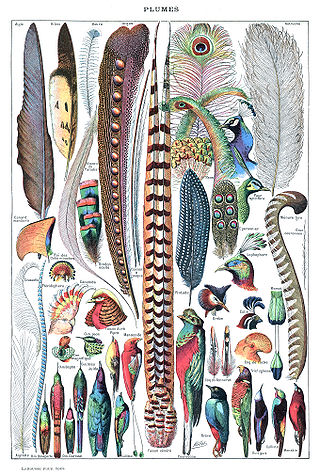
Feathers are epidermal growths that form a distinctive outer covering, or plumage, on both avian (bird) and some non-avian dinosaurs and other archosaurs. They are the most complex integumentary structures found in vertebrates and an example of a complex evolutionary novelty. They are among the characteristics that distinguish the extant birds from other living groups.

Peafowl is a common name for two bird species of the genus Pavo and one species of the closely related genus Afropavo within the tribe Pavonini of the family Phasianidae. Male peafowl are referred to as peacocks, and female peafowl are referred to as peahens.
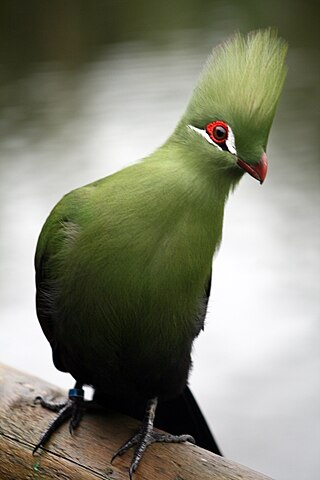
The turacos make up the bird family Musophagidae ( "banana-eaters"), which includes plantain-eaters and go-away-birds. In southern Africa both turacos and go-away-birds are commonly known as loeries. They are semi-zygodactylous: the fourth (outer) toe can be switched back and forth. The second and third toes, which always point forward, are conjoined in some species. Musophagids often have prominent crests and long tails; the turacos are noted for peculiar and unique pigments giving them their bright green and red feathers.
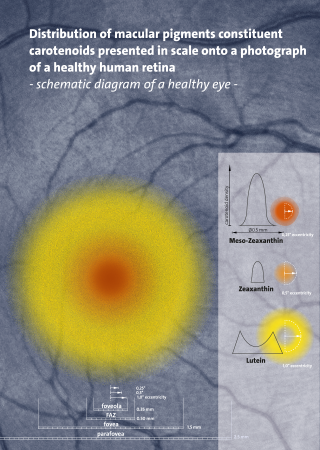
Carotenoids are yellow, orange, and red organic pigments that are produced by plants and algae, as well as several bacteria, archaea, and fungi. Carotenoids give the characteristic color to pumpkins, carrots, parsnips, corn, tomatoes, canaries, flamingos, salmon, lobster, shrimp, and daffodils. Over 1,100 identified carotenoids can be further categorized into two classes – xanthophylls and carotenes.

Iridescence is the phenomenon of certain surfaces that appear gradually to change colour as the angle of view or the angle of illumination changes. Iridescence is caused by wave interference of light in microstructures or thin films. Examples of iridescence include soap bubbles, feathers, butterfly wings and seashell nacre, and minerals such as opal. Pearlescence is a related effect where some or most of the reflected light is white. The term pearlescent is used to describe certain paint finishes, usually in the automotive industry, which actually produce iridescent effects.
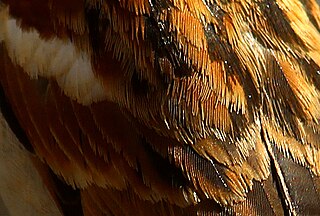
Plumage is a layer of feathers that covers a bird and the pattern, colour, and arrangement of those feathers. The pattern and colours of plumage differ between species and subspecies and may vary with age classes. Within species, there can be different colour morphs. The placement of feathers on a bird is not haphazard but rather emerges in organized, overlapping rows and groups, and these feather tracts are known by standardized names.

The Javan green magpie is a passerine bird in the crow family, Corvidae. This critically endangered species is endemic to montane forests on the Indonesian island of Java. It formerly included the Bornean green magpie as a subspecies, in which case the "combined" species was known as the short-tailed magpie.
CIDNP, often pronounced like "kidnip", is a nuclear magnetic resonance (NMR) technique that is used to study chemical reactions that involve radicals. It detects the non-Boltzmann (non-thermal) nuclear spin state distribution produced in these reactions as enhanced absorption or emission signals.

Biological pigments, also known simply as pigments or biochromes, are substances produced by living organisms that have a color resulting from selective color absorption. Biological pigments include plant pigments and flower pigments. Many biological structures, such as skin, eyes, feathers, fur and hair contain pigments such as melanin in specialized cells called chromatophores. In some species, pigments accrue over very long periods during an individual's lifespan.
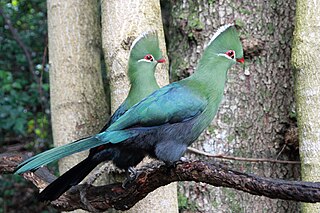
The Knysna turaco, or, in South Africa, Knysna loerie, is a large turaco, one of a group of African musophagidae birds. It is a resident breeder in the mature evergreen forests of southern and eastern South Africa, and Eswatini. It was formerly sometimes considered to be a subspecies of the green turaco of West Africa. The Livingstone's and Schalow's turacos were once considered subspecies.
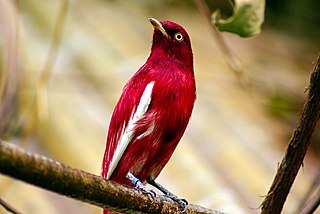
The pompadour cotinga is a species of bird in the family Cotingidae. This species lives in the Amazonian rainforest and has a range that extends across the Amazon Basin and includes Brazil, Peru, Colombia, Venezuela, and the Guianas. The pompadour cotinga is primarily a frugivore but has been known to consume insects on occasion. This species of cotinga is distinct in that the males have a burgundy head and body, bright white wings, and yellow eyes. Like other members of the Cotingidae, this species is sexually dimorphic and the females have a pale grey head and body. Although there are not many documented observations of the nesting behavior of these birds, the males are known to perform elaborate mating displays for the females who then raise the young alone.

Animal colouration is the general appearance of an animal resulting from the reflection or emission of light from its surfaces. Some animals are brightly coloured, while others are hard to see. In some species, such as the peafowl, the male has strong patterns, conspicuous colours and is iridescent, while the female is far less visible.

Psittacofulvin pigments, sometimes called psittacins, are responsible for the bright-red, orange, and yellow colors specific to parrots. In parrots, psittacofulvins are synthesized by a polyketide synthase enzyme that is expressed in growing feathers. They consist of linear polyenes terminated by an aldehyde group. There are five known psittacofulvin pigments - tetradecahexenal, hexadecaheptenal, octadecaoctenal and eicosanonenal, in addition to a fifth, currently-unidentified pigment found in the feathers of scarlet macaws. Colorful feathers with high levels of psittacofulvin resist feather-degrading Bacillus licheniformis better than white ones.
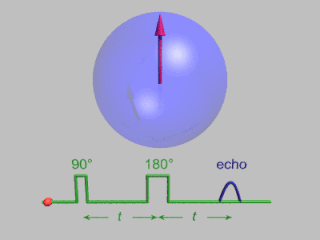
Pulsed electron paramagnetic resonance (EPR) is an electron paramagnetic resonance technique that involves the alignment of the net magnetization vector of the electron spins in a constant magnetic field. This alignment is perturbed by applying a short oscillating field, usually a microwave pulse. One can then measure the emitted microwave signal which is created by the sample magnetization. Fourier transformation of the microwave signal yields an EPR spectrum in the frequency domain. With a vast variety of pulse sequences it is possible to gain extensive knowledge on structural and dynamical properties of paramagnetic compounds. Pulsed EPR techniques such as electron spin echo envelope modulation (ESEEM) or pulsed electron nuclear double resonance (ENDOR) can reveal the interactions of the electron spin with its surrounding nuclear spins.

Turacoverdin is a unique copper uroporphyrin pigment responsible for the bright green coloration of several birds of the family Musophagidae, most notably the turaco. It is chemically related to turacin, a red pigment also found almost exclusively in turacos. Turacoverdin is one of the only true green pigments found in birds, as the coloration that appears in most green feathers is due to the unique properties of blue structural coloration in combination with yellow carotenoids. Turacoverdin and turacin were the first ever chemically characterized feather pigments, and turacoverdin was first isolated and described in 1882 by Dr. C.F.W. Krukenberg.

Dinosaur coloration is generally one of the unknowns in the field of paleontology, as skin pigmentation is nearly always lost during the fossilization process. However, recent studies of feathered dinosaurs and skin impressions have shown the colour of some species can be inferred through the use of melanosomes, the colour-determining pigments within the feathers.

Structural coloration in animals, and a few plants, is the production of colour by microscopically structured surfaces fine enough to interfere with visible light instead of pigments, although some structural coloration occurs in combination with pigments. For example, peacock tail feathers are pigmented brown, but their microscopic structure makes them also reflect blue, turquoise, and green light, and they are often iridescent.
Sir Arthur Herbert Church was a British chemist, expert on pottery, stones and chemistry of paintings, who discovered turacin in 1869 and several minerals, including the only British cerium mineral. He was also a talented artist and worked as a professor of chemistry at the Agricultural College in Cirencester and then at the Royal Academy of Arts. He wrote extensively on aspects of chemistry in agriculture, art, and daily life.

Sexual selection in birds concerns how birds have evolved a variety of mating behaviors, with the peacock tail being perhaps the most famous example of sexual selection and the Fisherian runaway. Commonly occurring sexual dimorphisms such as size and color differences are energetically costly attributes that signal competitive breeding situations. Many types of avian sexual selection have been identified; intersexual selection, also known as female choice; and intrasexual competition, where individuals of the more abundant sex compete with each other for the privilege to mate. Sexually selected traits often evolve to become more pronounced in competitive breeding situations until the trait begins to limit the individual's fitness. Conflicts between an individual fitness and signaling adaptations ensure that sexually selected ornaments such as plumage coloration and courtship behavior are "honest" traits. Signals must be costly to ensure that only good-quality individuals can present these exaggerated sexual ornaments and behaviors.

The Catalina macaw, sometimes known as the rainbow macaw is a first generation hybrid between the blue-and-gold macaw and scarlet macaw. As catalina macaws are hybrids, they do not have a true scientific name. The best way to represent these birds in taxonomy is by the expression Ara ararauna × Ara macao.


















